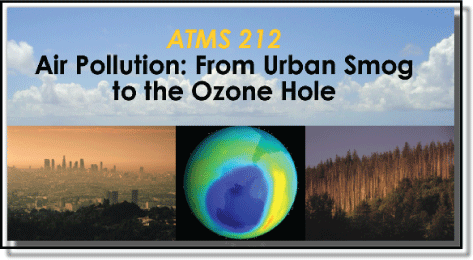
Air Pollution: From Urban Smog to the Ozone Hole
Start your research early to ensure success, and feel free to discuss your research with me at any point. This project forms 25% of your grade (15% for the paper, 10% for poster presentation), so you should expect to spent a lot of time on it. Poster presentations are scheduled for the last week of class. Your paper and poster are due on Monday, March 7 at 12:30pm.
The written paper must be a solid piece of writing. Your paper should be 1500 - 2000 words in length (about 5-6 pages of double spaced, 12 point Times New Roman font)**. The paper must include a title, introduction, discussion of the subject matter, and conclusion. Supplementary tables and figures are encouraged, and datasets, references and other sources of information used in the paper should be listed in sufficient detail at the end so that an interested reader would be able to locate them. You must use at least 3 separate references. At least two references must be from textbooks, other reference or scholarly books, or articles from well-recognized journals or science-oriented magazines (i.e. not a web site). You must list all your references, and any direct quotes must be indicated as such. Please be very careful about your referencing. If you copy any exact wording from one of your sources, you must cite the source in your text. If you fail to do so, you run the risk of plagiarizing. Even if you are paraphrasing in your own words something that is clearly another's idea or opinion, you must mention the source. Much of what you write should represent your own synthesis of what you've learned.
Your poster should summarize your work (one poster per person). Each student should obtain a piece of poster board, a trifold, or poster paper approximately 4'x3' in size. Each student should choose a title and write an introduction and conclusion. Each student should have her/his name on the poster, written underneath the title. Each student should then select at least 4 figures that illustrates his/her project. The figure can be a photograph, a graph, a sketch, or a table. Ideally, the figures should complement one another, forming the basis for your project's "story".
The point of your poster is to communicate your project with each other. Posters will be hung on the wall during the last week of class. Each student will have a scheduled day to present his/her poster. You will stand next to your poster during the poster symposium, and explain your project to anyone who pauses to look at your work. Each person in the class is required to review at least 6 posters (NOT your own) over the 5 day period. This will be part of your participation grade. Everyone must come to class every day that week, even if you are not presenting. Suggestions for preparing posters can be found here. The poster review form can be downloaded here.
** Note: If you are taking this class as a "W" course, you must write a paper 3000-3500 words in length (about 10-12 pages of double spaced, 12 point Times New Roman font). The first draft is due on Friday, March 4, 2011 at 12:30pm. I will provide comments to you by Monday, March 7, 2011. The paper must be revised based on my comments. The revised paper is due on the last day of class, Friday, March 11, 2011 at 12:30pm. For more info on the "W" requirement, click here.
Ecosystem effects of nitrogen deposition
Megacities and pollution
Effects of using biofuel on pollution
Clean coal technologies
Fuel and fuel additives
Health effects of a particular pollutant
Effects of air pollution on reproductive health
Arctic pollution
History and effectiveness of U.S. Clean Air Act
Air pollution trends in a particular country
Acidification of the ocean from increases in carbon dioxide emissions
Monitoring pollution from space (satellites)
The role of NGOs in air pollution legislation
The implications for a hydrogen economy
Air pollution in art
Environmental justice
Presentation Schedule for the Week of March 7:
Monday: Hanna Barket, Iris Albert, Kari Pietila, Rachel Wolk, Sofia Pylvainen, Amir Zahed and Cedric Allen
Tuesday: Anna Berentson, Elisa Dawson, Corissa Luedtke, Emma Vowels, Amy Anderson, Rebekah Reyes/Garret Brenden, Sarah Phenisee and Jacob Isenberg
Wednesday: Seamus Labrum/Max Mannisto, Laura Merle, Rhia Johnston, Min Hou, Tahira Al-Faham, Whitney Ballen and Teddi McFall
Thursday: Annie Weil, Nhung Tran, Korina Heard, Connor DiMaggio, Tsz-Man Poon, Cary Griffin, Marcus Gill and John Zemlin
Friday: Casey Young, Bruce Rickbeil, Megan Waskom, Nick Doepp, Matt Sefton, Sean Adhikari, Danica Hoeprich and Kiley Sullivan